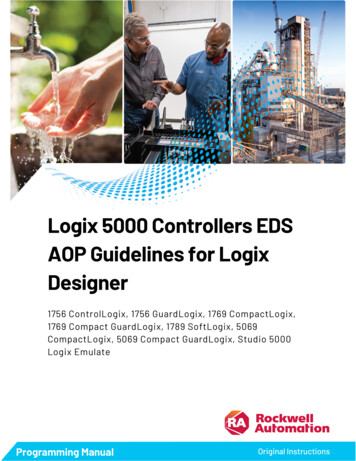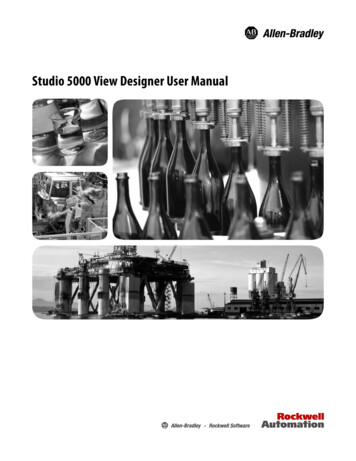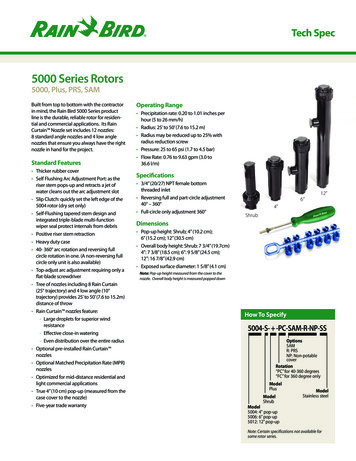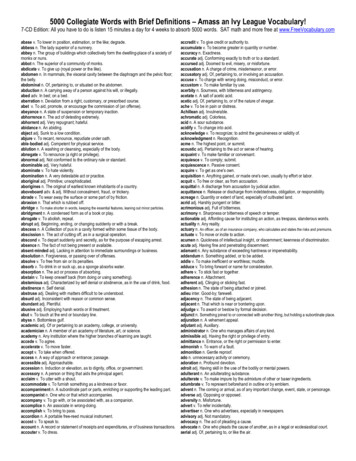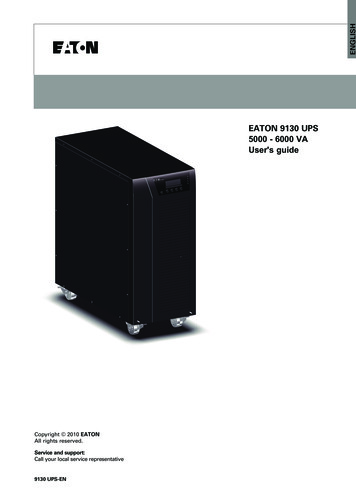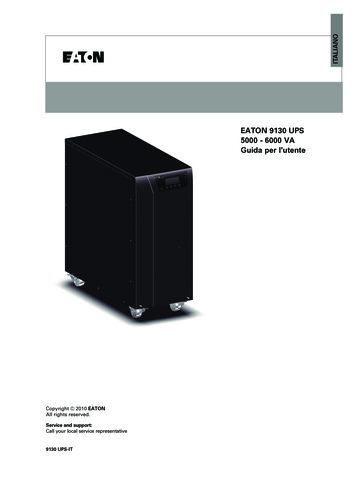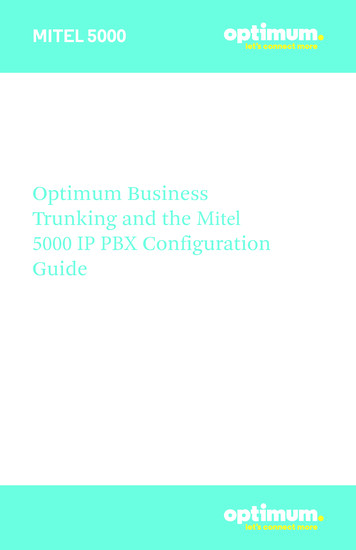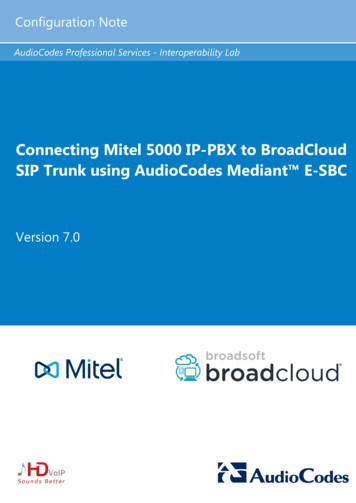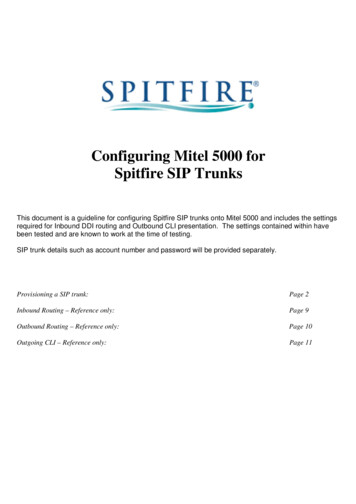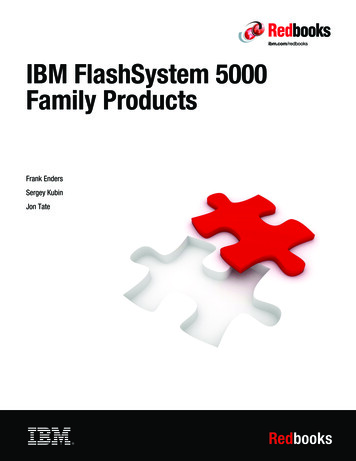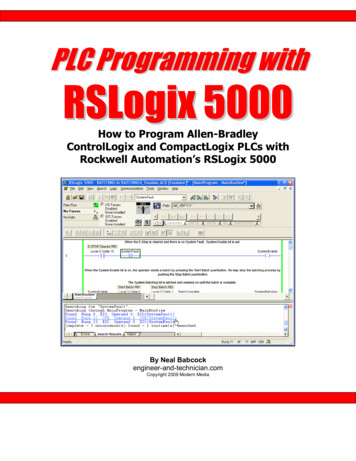
Transcription
PLC Programming withRSLogix 5000How to Program Allen-BradleyControlLogix and CompactLogix PLCs withRockwell Automation’s RSLogix 5000By Neal Babcockengineer-and-technician.comCopyright 2009 Modern Media
ContentsIntroduction . 4PLCs . 5Hardware. 6ControlLogix Processor. 6I/O Modules. 6Software . 7Getting The RSLogix 5000 Software. 7Ladder Logic . 7The Dialect of PLCs . 8Equivalent Logic . 12Project Scope. 14Summarizing the Scope . 20Which PLC? . 21Lay Out The I/O. 21Assigning I/O Addresses . 23Running RSLogix . 24Tags . 35Adding Descriptors To Your I/O . 37Writing the Program . 42Ladder View . 42Setting Up An Overall Control Rung . 42Starting a Batch Cycle . 57Batching Steps. 67Step 1 – Adding City Water. 67The Tag Database . 70Analog Inputs . 78Setting up the Analog Input Card to Calculate Tank Weight . 79Setting up the Analog Input Card to Calculate Tank Level. 81Back to Batching – Step 1. 83Step 2 – Adding Chemical KM . 89Step 3 – Adding Chemical KM . 92Step 4 – Blending. 93Step 5 – Pump to Filling Lines . 99Faults . 101Valve Position Faults . 101Console Status Indicators – Pilot Lights . 108Adding Rung Comments . 115Connecting To The PLC And Going Online. 119RSLogix Emulate 5000. 122RSLinx . 122Emulator. 124Editing in Run Mode . 1482PLC Programming with RSLogix 5000Copyright 2009 Modern Mediaengineer-and-technician.com
Run Mode on the Plant Floor . 153Add-On Instructions & Function Block Diagram Programming. 154Creating a Function Block Diagram . 156A Final Note About Our Program . 161How Do I . . . ? . 162Tips, Shortcuts and Warnings . 164Conclusion . 1673PLC Programming with RSLogix 5000Copyright 2009 Modern Mediaengineer-and-technician.com
IntroductionThe purpose of this book is to teach you how to set up, program and use an AllenBradley ControlLogix or CompactLogix. It will also familiarize you with the parts requiredfor a common application.It will tell you how to use RSLogix 5000 and how to write a ladder logic program.Since I feel the best way to learn any programming language is by using a real-worldexample, there is a sample project included in this book. This sample project, whichinvolves a chemical batching process, also contains a Project Scope. The ProjectScope, or Functional Specification, or whatever your company might call it, defines indetail how the system is to operate when the project is finished.You will learn, step by step, how to take a Project Scope and turn it into a working PLCprogram.The book will show you how to go online with your PLC to monitor your program toverify your ladder logic and make sure it is functioning properly.It will show you how to make changes to your program while you are online.It will show you the keystrokes and mouse movements that you need to know to useRSLogix 5000.Finally, it provides a number of tips and a Frequently Ask Questions section that willsave you hours of frustration.This book assumes you have a little background with PLCs – perhaps you have workedwith other PLCs from other manufacturers or you have helped to install and wire PLCs.Perhaps you are a Mechanical, Chemical or Process Engineer and you need to learnhow to use RSLogix 5000.If you need a more thorough understanding of basic PLC concepts, you might want totry the Beginner’s Guide to PLC Programming How to Program a PLC (ProgrammableLogic Controller). This ebook, along with the online tutorial, provides an example of howto automate a drill press, while explaining all the basic concepts of PLC programmingthat are necessary to write a solid PLC program.The Beginner’s Guide to PLC Programming works well in conjunction with this book, inthat it concentrates on basic PLC programming methods that are common to all types of4PLC Programming with RSLogix 5000Copyright 2009 Modern Mediaengineer-and-technician.com
PLCs. In addition, it provides an example of machine operation, whereas this book usesthe example of a chemical batching process.The Beginner’s Guide to PLC Programming is available from Modern Media for 9.95.Visit engineer-and-technician.com if you would like to learn more about this book.PLCsNearly all the industrial equipment that you find in a modern manufacturing facilityshares one thing in common - computer control. The most commonly used controller isthe PLC, or the Programmable Logic Controller, using a programming language calledLadder Logic. The language was developed to make programming easy for people whoalready understood how switches, relay contacts and coils work. Its format is similar tothe electrical style of drawing known as the “ladder diagram”.The most popular and most widely used manufacturer of PLCs is Rockwell Automation,who produces the Allen-Bradley ControlLogix and CompactLogix series of PLCs. TheControlLogix and CompactLogix families of processors and I/O modules are allprogrammed using Rockwell’s proprietary software known as RSLogix 5000.When you are finished with this book, you will be able to sit down in front of anycomputer running RSLogix 5000 and create a new program. You will be able to editexisting programs. You will be able to professionally document any changes you havemade.Rockwell Automation Technical SupportUnfortunately, we can’t anticipate all the problems you might face as you aretroubleshooting a program on the factory floor. There are just too many variables. Thisis why you must establish a relationship with your local Rockwell Automation technicalsupport team. Get to know them before you are in the final stages of a start-up and yourun into a problem. They are very helpful and they can save you hours of frustration.The Rockwell reps are not just technical support personnel; they are skilled engineersthat are responsible for running their own projects and writing and troubleshooting theirown programs. If you run into a problem, more than likely they have already seen it andhave come up with a solution.5PLC Programming with RSLogix 5000Copyright 2009 Modern Mediaengineer-and-technician.com
HardwareOne of the nice things about Allen-Bradley’s smaller PLCs is the relative simplicity ofassembling the hardware to create a system.First, let’s see what it takes to assemble a ControlLogix system. You only need to havea few components: a processor, a power supply, a rack and some I/O modules.ControlLogix ProcessorAt the time of this writing, there are 15 ControlLogix processors available. For ourapplication, the 1756-L55 processor will be fine.For your future projects, you will have to consider a number of factors before you makethe choice of your processor. Utilize your Rockwell representative and Rockwell’swebsite (www.ab.com) to help you in your choice.All the processors use RSLogix 5000, so any program you write for one processor couldbe adapted to run any other 1756 processor.I/O ModulesFor our system, we need discrete inputs, discrete outputs and analog inputs. Thesemodules will work fine for our application:1756-IA16 Digital AC Input Module (16 discrete inputs)1756-OA16 Digital AC Outputs (16 discrete outputs)1756-IF8 Analog Modules (8 single-ended analog inputs)6PLC Programming with RSLogix 5000Copyright 2009 Modern Mediaengineer-and-technician.com
SoftwareAll ControlLogix and CompactLogix processors use RSLogix 5000 software to programthe PLCs. Admittedly, the software is a bit pricey, but in my opinion, it is worth it.Getting The RSLogix 5000 SoftwareIf you don’t have access to a PLC, it would be well worth the effort to download thedemo version of RSLogix 5000. The demo runs for 90 days, and has some limitations,but you will be gaining experience with the real thing. Currently, the software is tware/design/rslogix5000/demo.html.There are 7 sections to download, totaling slightly over 480MB. Yes, it’s a big job todownload and install it, but it is essential.Ladder LogicBefore we open RSLogix 5000 and start programming, there are a few things you needto know about PLCs in general. I have summarized the basic terms and techniquesrequired to work with ladder logic. It isn’t a comprehensive summary, but if you are juststarting out, the information presented here will be very helpful.Every PLC programmer, no matter what skill level, must know the principles describedin this section and the Equivalent Logic section. There is simply no way around it.To effectively write a program, or even edit one, the programmer must know how tovisualize the effects of the changes he will make.In other words, you have to be able to look at the logic “on paper” and imagine how thelogic will work when it is entered into the PLC.7PLC Programming with RSLogix 5000Copyright 2009 Modern Mediaengineer-and-technician.com
The Dialect of PLCsLets' define some terms and symbols:INSTRUCTION – RSLogix’s Relay Ladder Logic command language is comprised of“instructions”. An XIC (it looks like a normally open contact --] [-- ) is an instruction. Atimer is an instruction. A few of the most common instructions are described below.BIT - an address within the PLC. It can be an input, output or internal coil, amongothers.RUNG - A section of the PLC ladder program that terminates in an output function ofsome type. Just like in an electrical ladder diagram, a rung has some type of output thatis turned on or turned off by the preceding entities in the ru
Before we open RSLogix 5000 and start programming, there are a few things you need to know about PLCs in general. I have summarized the basic terms and techniques required to work with ladder logic. It isn’t a comprehensive summary, but if you are just starting out, the information presented here will be very helpful. Every PLC programmer, no matter what skill level, must know the principles .

